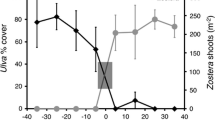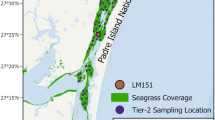Abstract
Seagrasses are threatened by human activity in many locations around the world. Their decline is often characterized by sudden ecosystem collapse from a vegetated to a bare state. In the 1930s, such a dramatic event happened in the Dutch Wadden Sea. Before the shift, large seagrass beds (Zostera marina) were present in this area. After the construction of a large dam and an incidence of the “wasting disease” in the early 1930s, these meadows became virtually extinct and never recovered despite restoration attempts. We investigated whether this shift could be explained as a critical transition between alternative stable states, and whether the lack of recovery could be due to the high resilience of the new turbid state. We analyzed the depth distribution of the historical meadows, a long-term dataset of key factors determining turbidity and a minimal model based on these data. Results demonstrate that recovery was impossible because turbidity related to suspended sediment was too high, probably because turbidity was no longer reduced by seagrass itself. Model simulations on the positive feedback suggest indeed the robust occurrence of alternative stable states and a high resilience of the current turbid state. As positive feedbacks are common in seagrasses, our findings may explain both the worldwide observed collapses and the low success rate of restoration attempts of seagrass habitats. Therefore, appreciation of ecosystem resilience may be crucial in seagrass ecosystem management.





Similar content being viewed by others
REFERENCES
Agawin NSR, Duarte GM. 2002. Evidence of direct particle trapping by a tropical seagrass meadow. Estuaries 25:1205–9
Bos AR, Van Katwijk MM. 2007. Planting density, hydrodynamic exposure and mussel beds affecting survival of transplanted intertidal eelgrass. Mar Ecol Prog Ser 336:121–9
Bouma TJ, De Vries MB, Low E, Peralta G, Tanczos C, Van de Koppel J, Herman PMJ. 2005. Trade-offs related to ecosystem engineering: a case study on stiffness of emerging macrophytes. Ecology 86:2187–99
Carpenter SR, Ludwig D, Brock WA. 1999. Management of eutrophication for lakes subject to potentially irreversible change. Ecol Appl 9:751–71
Christiansen C, Volund G, Lund-Hansen LC, Bartholdy J. 2006. Wind influence on tidal flat sediment dynamics: field investigations in the Ho Bugt, Danish Wadden Sea. Mar Geol 235:75–86
Colijn F. 1982. Light-absorption in the waters of the Ems-Dollard estuary and its consequences for the growth of phytoplankton and microphytobenthos. Neth J Sea Res 15:196–216
Condie SA, Sherwood CR. 2006. Sediment distribution and transport across the continental shelf and slope under idealized wind forcing. Prog Oceanogr 70:255–70
Davies AM, Lawrence J. 1994. Examining the influence of wind and wind-wave turbulence on tidal currents, using a 3-dimensional hydrodynamic model including wave-current interaction. J Phys Oceanogr 24:2441–60
De Jonge VN, De Jong DJ. 2002. ‘Global change’ impact of inter-annual variation in water discharge as a driving factor to dredging and spoil disposal in the river Rhine system and of turbidity in the Wadden Sea. Estuar Coast Shelf Sci 55:969–91
Den Hartog C, Polderman PJG. 1975. Changes in the seagrass populations of the Dutch Wadden Sea. Aquat Bot 1:141–7
Duarte CM. 2002. The future of seagrass meadows. Environ Conserv 29:192–206
Edelvang K, Austen I. 1997. The temporal variation of flocs and fecal pellets in a tidal channel. Estuar Coast Shelf Sci 44:361–7
Fonseca MS, Cahalan JA. 1992. A preliminary evaluation of wave attenuation by 4 species of seagrass. Estuar Coast Shelf Sci 35:565–76
Gacia E, Duarte CM. 2001. Sediment retention by a mediterranean Posidonia oceanica meadow: the balance between deposition and resuspension. Estuar Coast Shelf Sci 52:505–14
Gallegos CL. 2001. Calculating optical water quality targets to restore and protect submersed aquatic vegetation: overcoming problems in partitioning the diffuse attenuation coefficient for photosynthetically active radiation. Estuaries 24:381–97
Gambi MC, Nowell ARM, Jumars PA. 1990. Flume observations on flow dynamics in Zostera marina (eelgrass) beds. Mar Ecol Prog Ser 61:159–69
Giesen WBJT, Van Katwijk MM, Den Hartog C. 1990. Eelgrass condition and turbidity in the Dutch Wadden Sea. Aquat Bot 37:71–85
Granata TC, Serra T, Colomer J, Casamitjana X, Duarte CM, Gacia E. 2001. Flow and particle distributions in a nearshore seagrass meadow before and after a storm. Mar Ecol Prog Ser 218:95–106
Greve TM, Krause-Jensen D. 2005. Predictive modelling of eelgrass (Zostera marina) depth limits. Mar Biol 146:849–58
Houwing EJ. 1999. Determination of the critical erosion threshold of cohesive sediments on intertidal mudflats along the Dutch Wadden Sea Coast. Estuar Coast Shelf Sci 49:545–55
Jackson JBC, Kirby MX, Berger WH, Bjorndal KA, Botsford LW, Bourque BJ, Bradbury RH, Cooke R, Erlandson J, Estes JA, Hughes TP, Kidwell S, Lange CB, Lenihan HS, Pandolfi JM, Peterson CH, Steneck RS, Tegner MJ, Warner RR. 2001. Historical overfishing and the recent collapse of coastal ecosystems. Science 293:629–38
Janssen-Stelder B. 2000. The effect of different hydrodynamic conditions on the morphodynamics of a tidal mudflat in the Dutch Wadden Sea. Cont Shelf Res 20:1461–78
Kemp WM, Boynton WR, Adolf JE, Boesch DF, Boicourt WC, Brush G, Cornwell JC, Fisher TR, Glibert PM, Hagy JD, Harding LW, Houde ED, Kimmel DG, Miller WD, Newell RIE, Roman MR, Smith EM, Stevenson JC. 2005. Eutrophication of Chesapeake Bay: historical trends and ecological interactions. Mar Ecol Prog Ser 303:1–29
Kleinhans MG, Grasmeijer BT. 2006. Bed load transport on the shoreface by currents and waves. Coast Eng 53:983–96
Klok B, Schalkers KM. 1980. De verandering in de Waddenzee ten gevolge van de afsluiting van de Zuiderzee. In Rijkswaterstaat, directie waterhuishuiding en waterbeweging, district kust en zee, Hoorn
Knowlton N. 2004. Multiple “stable” states and the conservation of marine ecosystems. Prog Oceanogr 60:387–96
Le Roux JP. 2005. Grains in motion: a review. Sediment Geol 178:285–313
Marbà N, Hemminga MA, Duarte CM. 2006. Resource translocation within seagrass clones: allometric scaling to plant size and productivity. Oecologia V150:362–72
Meijer ML, de Boois I, Scheffer M, Portielje R, Hosper H. 1999. Biomanipulation in shallow lakes in The Netherlands: an evaluation of 18 case studies. Hydrobiologia 409:13–30
Moore KA. 2004. Influence of seagrasses on water quality in shallow regions of the lower Chesapeake Bay. J Coast Res 62–178
Olsen JL, Stam WT, Coyer JA, Reusch TBH, Billingham M, Bostrom C, Calvert E, Christie H, Granger S, La Lumiere R, Milchakova N, Oudot-Le Secq MP, Procaccini G, Sanjabi B, Serrao E, Veldsink J, Widdicombe S, Wyllie-Echeverria S. 2004. North Atlantic phylogeography and large-scale population differentiation of the seagrass Zostera marina L. Mol Ecol 13:1923–41
Orth RJ, Carruthers TJB, Dennison WC, Duarte CM, Fourqurean JW, Heck KL, Hughes AR, Kendrick GA, Kenworthy WJ, Olyarnik S, Short FT, Waycott M, Williams SL. 2006. A global crisis for seagrass ecosystems. Bioscience 56:987–96
Oudemans CAJA. 1870. Verslag der Staatscommissie inzake de wiervisscherij. The Hague
Pejrup M, Edelvang K. 1996. Measurements of in situ settling velocities in the Elbe estuary. J Sea Res 36:109–13
Pellikaan GC. 1980. De verspreiding en de groei van zeegras, Zostera marina L., in relatie tot de instraling. Delta Institute for Hydrobiological Research, Yerseke, The Netherlands
Peterson CH, Luettich RA, Micheli F, Skilleter GA. 2004. Attenuation of water flow inside seagrass canopies of differing structure. Mar Ecol Prog Ser 268:81–92
Postma H. 1961. Transport and accumulation of suspended matter in the Dutch Wadden Sea Netherlands J Sea Res 1:148–90
Reigersman CAJ. 1939. Rapport omtrent de invloed van de wierziekte op de achteruitgang van de wierbedrijven. The Hague
Ross J, Sulev M. 2000. Sources of errors in measurements of PAR. Agric For Meteorol 100:103–25
Royal Dutch Meteorological Institute. 2006. Klimaatdata en Advies: langjarige gemiddelden en extremen, tijdvak 1971–2000. In KNMI, De Bildt
Scheffer M, Carpenter SR. 2003. Catastrophic regime shifts in ecosystems: linking theory to observation. Trends Ecol Evol 18:648–56
Scheffer M, Hosper SH, Meijer ML, Moss B, Jeppesen E. 1993. Alternative equilibria in shallow lakes. Trends Ecol Evol 8:275–9
Scheffer M, Carpenter S, Foley JA, Folke C, Walker B. 2001. Catastrophic shifts in ecosystems. Nature 413:591–6
Twilley RR, Kemp WM, Staver KW, Stevenson JC, Boynton WR. 1985. Nutrient enrichment of estuarine submersed vascular plant-communities. 1. Algal growth and effects on production of plants and associated communities. Mar Ecol Prog Ser 23:179–91
Van der Molen J, Van Dijck B. 2000. The evolution of the Dutch and Belgian coasts and the role of sand supply from the North Sea. Glob Planet Change 27:223–44
Van Goor ACJ. 1919. Het zeegras (Zostera marina L.) en zijn betekenis voor her leven der visschen. 1(4)
Van Katwijk MM, Hermus DCR. 2000. Effects of water dynamics on Zostera marina: transplantation experiments in the intertidal Dutch Wadden Sea. Mar Ecol Prog Ser 208:107–8
Van Katwijk MM, Hermus DCR, de Jong DJ, Asmus RM, De Jonge VN. 2000. Habitat suitability of the Wadden Sea for restoration of Zostera marina beds. Helgol Mar Res 54:117–128
Van Lent F, Verschuure JM. 1994. Intraspecific variability of Zostera marina L. (eelgrass) in the estuaries and lagoons of the Southwestern Netherlands. 1. Population-dynamics. Aquat Bot 48:31–58
Van Nes EH, Scheffer M. 2005. Implications of spatial heterogeneity for catastrophic regime shifts in ecosystems. Ecology 86:1797–807
Van Rijn LC. 1990. Principles of fluid flow and surface waves in rivers, estuaries, seas and oceans. Oldemarkt: Aqua Publications
Verhagen JHG, Nienhuis PH. 1983. A simulation-model of production, seasonal changes in biomass and distribution of eelgrass (Zostera marina) in Lake Grevelingen. Mar Ecol Prog Ser 10:187–95
Ward LG, Kemp WM, Boynton WR. 1984. The influence of waves and seagrass communities on suspended particulates in an estuarine embayment. Mar Geol 59:85–103
Worcester SE. 1995. Effects of eelgrass beds on advection and turbulent mixing in low current and low shoot density environments. Mar Ecol Prog Ser 126:223–32
Zimmerman RC, Reguzzoni JL, Alberte RS. 1995. Eelgrass (Zostera marina L.) transplants in San-Francisco Bay. Role of light availability on metabolism, growth and survival. Aquat Bot 51:67–86
ACKNOWLEDGMENTS
We thank D. J. de Jong, M. B. de Vries, M. J. F. Stive, P. M. J. Herman and two anonymous referees for their valuable comments on preliminary drafts of this manuscript. We are also grateful to Rijkswaterstaat (Dutch National Institute for Coastal and Marine Management, RIKZ) for providing important data and support. This study is financially supported by the Netherlands Organization of Scientific Research/Earth and Life Sciences (NWO-ALW).
Author information
Authors and Affiliations
Corresponding author
Rights and permissions
About this article
Cite this article
van der Heide, T., van Nes, E.H., Geerling, G.W. et al. Positive Feedbacks in Seagrass Ecosystems: Implications for Success in Conservation and Restoration. Ecosystems 10, 1311–1322 (2007). https://doi.org/10.1007/s10021-007-9099-7
Received:
Revised:
Accepted:
Published:
Issue Date:
DOI: https://doi.org/10.1007/s10021-007-9099-7




